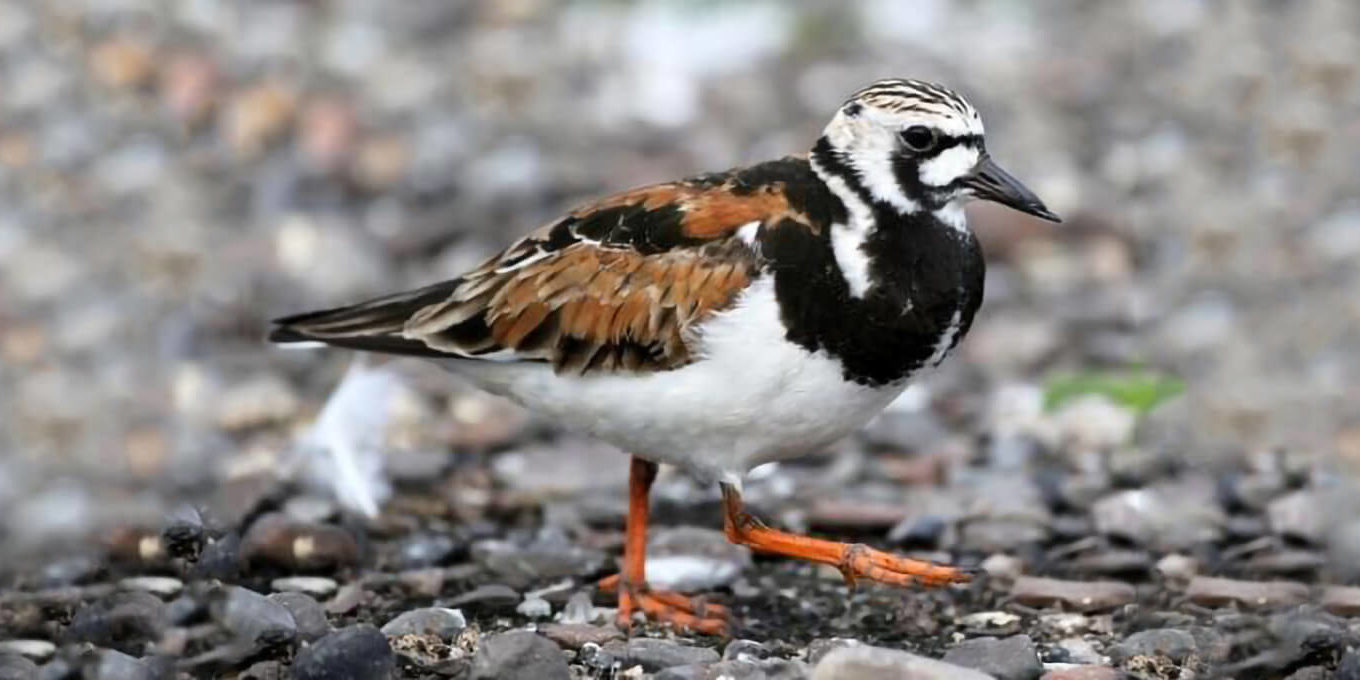Bird of The Week: Ruddy Turnstone
SCIENTIFIC NAME: Arenaria interpres
POPULATION: Global: 460,000-730,000; North American: 245,000
TREND: Stable
HABITAT: Breeds along rocky Arctic coasts and tundra; winters on rocky shorelines, mudflats, and beaches
The Ruddy Turnstone is a stocky shorebird named for its habit of flipping over stones, shells, and seaweed with a slightly upturned, wedge-shaped bill. During the breeding season, its bright orange legs and harlequin-like plumage are unmistakable. This eye-catching pattern provides camouflage among the rocks and debris where this bird is most often found.
Life along rocky shorelines requires other adaptations: Ruddy Turnstones have short, powerful legs and a low center of gravity that helps them balance. Slightly spiny feet and short, curved toenails provide added grip on slippery surfaces.
Ruddy Turnstones are long-distance migrants with a worldwide distribution. They’re found in at least five different populations on both North American coasts as well as in South America, Eurasia, Africa, and Australia. All North American populations breed in the Arctic and travel and winter in large flocks that may include other shorebirds such as Red Knot, Dunlin, and Semipalmated Sandpiper.
Ruddy Turnstone is one of only two turnstone species in the world. The other is Black Turnstone, a species with a more limited distribution within the Americas. It’s possible to see both turnstone species along the west coast of North America during the nonbreeding season.
Opportunistic Eater
Varying its diet with the season, this species an opportunistic forager. While breeding, Ruddy Turnstones mostly eat insects, particularly the flies and their larvae that are so abundant during the Arctic summer. They also eat berries and other plant matter, steal eggs from other bird species, and even scavenge on carrion and discarded human food.
During migration and in the winter, Ruddy Turnstones specialize in eating crustaceans, mollusks, and other marine invertebrates. They are particularly skilled at dislodging and opening mollusks and barnacles.
Dad’s in Charge
The normally sociable Ruddy Turnstone becomes territorial and aggressive during the breeding season, even taking on much-larger birds that enter the turnstone’s territory. Males and females renew and strengthen their pair bonds through noisy courtship displays on the ground and in the air; these displays can be initiated by either sex.
Like many other shorebirds, including Wilson’s Plover and Mountain Plover, newly hatched Ruddy Turnstone chicks are mobile and able to feed themselves. They leave the nest within a day, initially guarded and escorted by both parents to nearby food sources. While the female usually leaves the family group within a week or two, the male stays with the young until they fledge.
Fast Flyers
These migratory birds have a long way to travel, and they fly fast in the process. Researchers have clocked turnstones flying at 27 to 47 miles per hour! Chicks learn to fly at only 19 days old and depart for their wintering grounds soon after. They make this first migration on their own, since the adult birds will have departed by this time.
Young birds remain on their wintering grounds throughout their first year after hatching and begin to breed in their second year, although breeding may be delayed until 3 or 4 years of age.
Home Is Where the Habitat Is
Although not considered threatened, Ruddy Turnstones are affected by many of the factors that impact shorebirds worldwide, particularly habitat loss and global climate change. The impact of coastal habitat loss is critical during migration, especially at important staging areas such as the Delaware Bay, where horseshoe crab eggs are an important food resource for these birds.
LOCALLY: You can find them along the coast, north of Cayucos on the Estero trail.
Source: American Bird Conservancy abc.org


